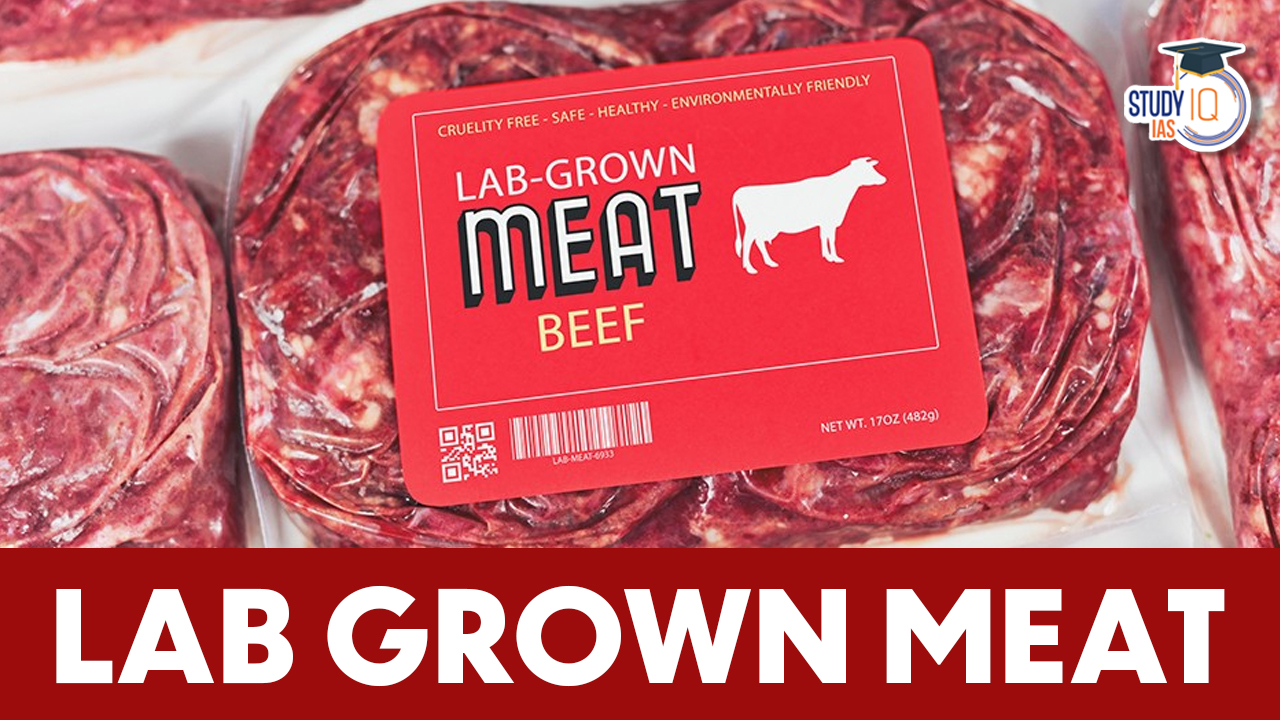Table of Contents
Context: Two California-based companies were cleared to make and sell cell-cultivated chicken, the ‘official’ name of chicken meat that is grown in a laboratory for human consumption.
More on the News
- The companies, Good Meat and Upside Foods have obtained approval from the U.S. government to produce and sell cell-cultivated chicken.
- To secure this approval, the companies had to evaluate the safety of their facilities and the accuracy of their production processes.
- They needed guidance from the Food and Drug Administration (FDA) to instil confidence among consumers and investors. If the FDA is satisfied with the company’s assessments and submissions, it issues a “no questions” letter, indicating its implicit approval.
- As both companies met the necessary requirements and regulatory standards, they have been permitted to produce and sell their cell-cultivated chicken products in the United States.
What is Cell Cultivated/Lab Grown Meat?
- Cell-cultivated chicken refers to meat that is produced through a process called cell culture or cell cultivation.
- Instead of raising and slaughtering live animals, the meat is grown from animal cells in a laboratory setting.
- The process involves isolating cells from the chicken, such as muscle cells, and providing them with the necessary nutrients, growth factors, and environmental conditions to replicate and grow.
- These cells multiply and develop into muscle tissue, which is the main component of chicken meat.
- Over time, the cell-cultivated meat accumulates and forms a mass of minced meat that can be further processed and transformed into various chicken products.
- Additives may be used to enhance the texture and taste of the final product.
- The goal of cell-cultivated chicken is to provide an alternative method of meat production that reduces reliance on traditional animal agriculture and offers a more sustainable and environmentally-friendly approach.

Existing Forms of Cell Cultivated Meat
Currently, the field of cell-cultivated meat is still in its early stages of development, and the commercial availability of different types of cell-cultivated meat is limited.
- Chicken is the second most widely consumed meat in the world, according to the UN Food and Agriculture Organization (FAO).
- However, in the U.S. it has been the highest consumed meat since 2010. Good Meat and Upside have focused on chicken, and plan to expand their offerings to include other meats in the future.
- Reports note that “beef, with its higher fat content and more complex flavour, is harder to replicate.”
- Researchers are also developing cell-cultivated versions of sea bass, tuna, and shrimp.
- A 2021 report estimated that there were 107 companies in 24 countries working on developing similar alternatives to meat (two companies were from India).
Need for Cell-Cultivated Meat
Cell-cultivated meat was created to address several key issues and challenges associated with traditional animal agriculture.
- Climate Mitigation:
- One of the primary motivations behind cell-cultivated meat is to reduce the environmental impact of livestock production.
- Traditional animal agriculture, particularly the production of beef, contributes significantly to greenhouse gas emissions.
- By producing meat through cell culture, it is expected to reduce emissions associated with livestock farming and contribute to climate change mitigation.
- Land Use Efficiency:
- Cell-cultivated meat has the potential to utilize land more efficiently compared to traditional livestock farming.
- Livestock farming requires vast amounts of land for animal grazing, feed production, and infrastructure.
- Cell-cultivated meat production, on the other hand, could require significantly less land, potentially helping to conserve natural habitats and reduce deforestation.
- Animal Welfare:
- Concerns about animal welfare and the ethical treatment of animals in traditional farming practices have led to the development of cell-cultivated meat.
- By producing meat directly from animal cells, it eliminates the need for raising and slaughtering animals, thus reducing animal suffering and cruelty associated with industrial farming practices.
- Food Security:
- With the global population projected to increase in the coming decades, there are concerns about meeting the growing demand for food.
- Cell-cultivated meat is seen as a potential solution to enhance food security by providing a sustainable and resource-efficient method of meat production.
- It offers the possibility of producing meat at scale, reducing reliance on traditional livestock farming and its limitations.
Concerns
The challenges of cell-cultivated meat can be broadly categorized into four areas:
- Consumer Acceptance: One of the key challenges is achieving widespread consumer acceptance of cell-cultivated meat. It needs to closely match the taste, texture, and appearance of traditional animal meat to gain market traction.
- Cost: The cost of cell-cultivated meat production remains a significant challenge. Currently, the production process is expensive, and it is expected to remain so in the near future. The cost of obtaining high-quality cells, the development and maintenance of suitable growth media, and the implementation of quality control measures can contribute to the high costs.
- Resources and Cultivation: Cell-cultivated meat production requires a range of resources. Obtaining high-quality cells for cultivation, developing suitable growth media, and ensuring optimal conditions for cell culture are crucial. Scaling up production while maintaining quality and efficiency presents a complex challenge. Efficient utilization of resources and optimizing the cultivation process are areas of focus for researchers and companies.
- Environmental Impact and Uncertainties: There are uncertainties regarding the environmental impact of cell-cultivated meat production. While it is expected to have a lower environmental footprint compared to traditional animal agriculture, there are concerns related to the sourcing of growth media and the overall energy-intensive nature of the process. The environmental impact can vary based on the specific production methods and resources used.


 Phone-tapping in India, Legal Framework ...
Phone-tapping in India, Legal Framework ...
 Bihar Assembly Election 2025 Dates, Poli...
Bihar Assembly Election 2025 Dates, Poli...
 Jharkhand High Court Assistants Admit Ca...
Jharkhand High Court Assistants Admit Ca...





















